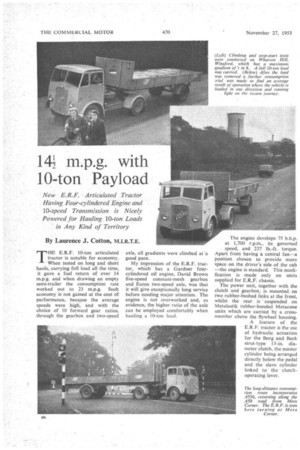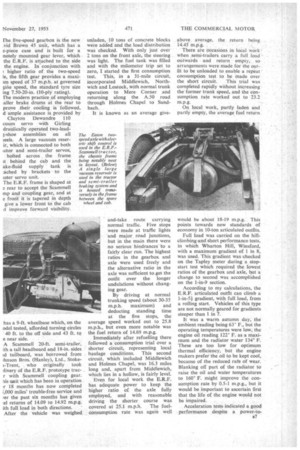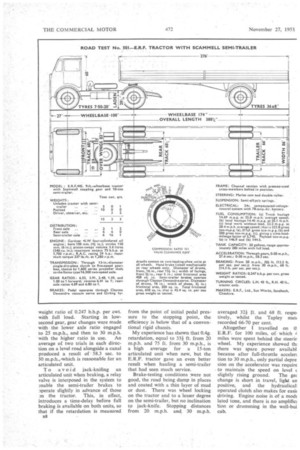144, m.p.g. with 10-ton Payload
Page 40

Page 41

Page 42

If you've noticed an error in this article please click here to report it so we can fix it.
New. E.R.F. Articulated Tractor Having Four-cylindered Engine and 10-speed Transmission is Nicely Powered for Hauling 10-ton Loads
in Any Kind of Territory
By Laurence J. Cotton, M.I.R.T.E.
THE E.R.F. 10-ton articulated tractor is notable for economy. When tested on long and short hauls, carrying full load all the time, it gave a fuel return of over 14 m.p.g. and when drawing an empty semi-trailer the consumption rate worked out to 23 m.p.g. Such economy is not gained at the cost of performance, because the average speeds were high, and with the choice of 10 forward gear ratios, through the gearbox and two-speed
axle, all gradients were climbed at 'a good pace.
My impression of the E.R.F. tractor, which has a Gardner fourcylindered oil engine, David Brown five-speed constant-mesh gearbox and Eaton two-speed axle, was that it will give exceptionally long service before needing major attention. The engine is not overworked and, as evidence, the higher ratio of the axle can be employed comfortably when hauling a 10-ton load. The engine develops 75 b.h.p. at 1,700 r.p.m., its governed speed, and 237 lb.-ft. torque. Apart from having a central fan—a Position chosen to provide more space on the driver's side of the cab --the engine is standard. This modi fication is made only on units supplied for E.R.F. chassis.
The power unit, together with the clutch and gearbox, is mounted on two rubber-bushed links at the front, whilst the rear is " suspended on Metalastik rubber-bonded Metacone units which are carried by a crossmember above the flywheel housing.
A feature of the E.R.F. tractor is the use of hydraulic actuation for the Borg and Beek strut-type 13-in, diameter dutch, the master cylinder being arranged directly below the pedal and the slave cylinder linked to the clutchoperating lever. The five-speed gearbox is the new .vid Brown 45 unit, which has a e-piece case and is built for a notely mounted gear lever, which the E.R.F. is attached to the side the engine. In conjunction with : higher ratio of the two-speed le, the fifth gear provides a maxim speed of 37 m.p.h. at governed gine speed, the standard tyre size ing 7.50-20-in. (10-ply rating).
The modern practice of employing Latter brake drums at the rear to prove their cooling is followed, d ample assistance is provided by Clayton Dewandre 110 cuum servo with curling draulicatly operated two-leadg-shoe assemblies on all keels. A large vacuum reserir, which is connected to both ictor and semi-trailer servos, bolted across the frame a behind the cab and the ake-fluid supply tank is :ached by brackets to the aster servo unit.
The E.R.F. frame is shaped at e rear to accept the Scammell mp and coupling gear, and at e front it is tapered in depth give a lower front to the cab d improve forward visibility.
has a 9-ft. wheelbase which, on the odd tested, afforded turning circles 40 ft. to the off side and 43 ft. to e near side.
A Scammell 20-ft. semi-trailer, [th a tall headboard and 18-in, sides id tailboard, was borrowed from ihnson Bros. (Hanky), Ltd., Stoke1-Trent, who originally took :livery of the E.R.F. prototype tracr with Scammell coupling gear. ais unit which has been in operation T 18 months has now completed ,000 miles' trouble-free service and ter the past six months has given .el returns of 14.09 to 14.92 m.p.g.
ith full load in both directions. ' After the vehicle was weighed unladen, 10 tons of concrete blocks were added and the load distribution was checked. With only just over 2 tons on the front axle, the steering was light. The fuel tank was filled and with the milometer trip set to zero, I started the first consumption test. This, in a 31-mile circuit, incorporated Middlewich, Northwich and Lostock, with normal trunk operation to Mere Corner and returning along the A.50 road through Holmes Chapel to Sandbach.
It is known as an average give and-take route carrying normal traffic. Five stops were made at traffic lights and major road junctions, but in the main there were no serious hindrances -to a fairly clear run. The highest ratios in the gearbox and axle were used freely and the alternative ratio in the axle was sufficient to,get the outfit over the longer undulations without changing gear.
By driving at normal trunking speed (about 30-35 m.p.h. maximum) and deducting standing time at the five stops, the average speed worked out to 25.8 m.p.h., but even more notable was the fuel return of 14.69 m.p.g.
Immediately after refuelling there followed a consumption trial over a shorter circuit, representing local haulage conditions. This second circuit, which included Middlewich and Holmes Chapel, was 16.3 miles long and, apart from Middlewich, which lies in a hollow, is fairly level.
Even for local work the E.R.F. has adequate power to keep the higher ratio of the axle fully employed, and with reasonable driving the shorter course was covered at 25.1 m.p.h. The fuelconsumption rate was again well above average, the return being 14.45 m.p.g.
There are occasions in local work when semi-trailers carry a full load outwards and return empty, so arrangements were made for the outfit to be unloaded to enable a repeat' consumption test to be made over the short circuit. This trial was completed rapidly without increasing the former trunk speed, and the consumption rate worked out to 23.2 m.p.g.
On local work, partly laden and partly empty, the average fuel return would be about 18-19 m.p.g. This points towards new standards of economy in 10-ton articulated outfits.
Full load was carried on the hillclimbing-and short performance tests, in which Wharton Hill, Winsford, with a maximum gradient of 1 in 8, was used. This gradient was checked on the Tapley meter during a stopstart test which required the lowest ratios of the gearbox and axle, but a change to second was accomplished on the 1-in-9 section.
According to my calculations, the E.R.F. articulated outfit can climb a 1-in-51gradient, with full load, from a rolling start. Vehicles of this type are not normally geared for gradients steeper than 1 in 7.
It was a warm autumn day, the ambient reading being 63° F., but the operating temperatures were low, the engine oil reading 122° F. as a maximum and the radiator water 134° F. These are too low for optimum thermal efficiency, but the engine makers prefer the oil to be kept cool, because of the reduced rate of wear. Blanking off part of the radiator to raise the oil and water temperatures to 160° F. might improve the consumption rate by 0.5-1 m.p.g., but it would be important to ascertain first that the life of the engine would not be impaired.
Acceleration tests indicated a good performance despite a power-toe7 weight ratio of 0.247 b.h.p. per cwt. with full load. Starting in lowsecond gear, gear changes were made with the lower axle ratio engaged to 25 m.p.h., and then to 30 m.p.h.
with the higher ratio in use. An average of two trials in each direction on a level road alongside a canal produced a result of 58.3 sec. to 30 m.p,h,,,which is reasonable for an articulated unit.
To a v old jack-knifing an articulated unit when braking, a relay valve is interposed in the system to mable the semi-trailer brakes to verate slightly in advance of those Da the tractor. This, in effect, introduces a time-delay before full braking is available on both units, so that if the retardation is measured 138 from the point of initial pedal pressure to the stopping point, the efficiency is below that of a conventional rigid chassis, My experience has shown that 0.4g. retardation, equal to 33i ft. from 20 m.p.h. and 75 ft. from 30 m.p.h., is a high average for a 15-ton articulated unit when new, but the E.R.F. tractor gave an even better result when hauling a semi-trailer that had seen much service.
Brake-testing conditions were not good, the road being damp in places and coated with a thin layer of mud or dust. There was wheel locking on the tractor and to a lesser degree on the semi-trailer, but no inclination to jack-knife, Stopping distances from 20 m.p.h. awl 30 mph. averaged 324 ft. and 68 ft. respel tively, whilst the Tapley mett recorded 66-70 per cent.
Altogether I travelled on tf E.R.F. for 100 miles, ofwhich 4 miles were spent behind the steerin wheel. My experience showed there was spare power availabI because after full-throttle aced.= lion to 30 m.p.h., only partial depre sion on the accelerator was require to maintain the speed on level
slightly rising ground. The ge2 change is short in travel, light an positive, and the hydraulicall operated clutch also makes for easit driving. Engine noise is of a modi lated tone, and there is no amplific ton or drumming in the well-bui cab.




























































































